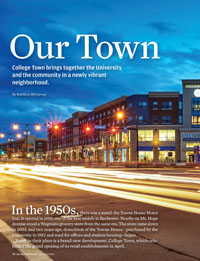Features
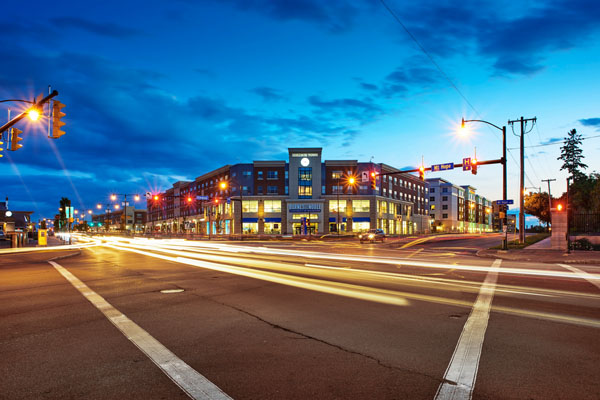 OUT ON THE TOWN: College Town has a deliberately urban feel, with wide sidewalks and large storefront windows. The development
brings students and faculty into the Mt. Hope Avenue area in greater numbers and was designed to provide desired amenities
to the surrounding neighborhood. (Photo: Adam Fenster)
OUT ON THE TOWN: College Town has a deliberately urban feel, with wide sidewalks and large storefront windows. The development
brings students and faculty into the Mt. Hope Avenue area in greater numbers and was designed to provide desired amenities
to the surrounding neighborhood. (Photo: Adam Fenster)In the 1950s, there was a motel: the Towne House Motor Inn. It opened in 1958, one of the first motels in Rochester. Nearby on Mt. Hope Avenue stood a Wegmans grocery store from the same era. The store came down in 2003, and two years ago, demolition of the Towne House—purchased by the University in 1982 and used for offices and student housing—began.
Today in their place is a brand-new development, College Town, which celebrated the grand opening of its retail establishments in April.
“I was impressed when the buildings started taking shape, to go to the site and see how large it was,” says Ronald Paprocki ’69, ’86S (MBA), senior vice president for administration and finance. He has overseen the project, helping shepherd it from an idea in the University’s Campus Master Plan to a brick-and-mortar reality.
College Town is extensive—a mixed-use development on more than 14 acres of land owned by the University between Elmwood Avenue and Crittenden Boulevard. Anchored by a Barnes & Noble bookstore on the corner of Elmwood and Mt. Hope avenues, it also features a Hilton Garden Inn Hotel, restaurants, coffee shops, a bakery that will deliver warm cookies to students studying into the wee hours, a yoga studio, a grocery store, other shops, a parking garage, and 152 apartments. The project involves nearly one million square feet of space—space that recently had been largely surface parking lots.
“There’s so much more there now than there was before,” says Dan Hurley, president of the Upper Mt. Hope Neighborhood Association. “We’re excited to connect with more people, and for more people to move here and get involved.”
The project “took a largely underutilized site and brought vibrancy back to the neighborhood,” says Matthew McCarthy, senior economic development specialist in the City of Rochester’s Department of Neighborhood and Business Development.
Such efforts are a strategically important aspect of the University’s plans for the future. In “The Next Level,” a white paper released earlier this year, President and CEO Joel Seligman outlines four major areas that the University will make priorities for the next five years. One of those is revitalization of the community. “The stronger our community is, the stronger the University will be,” Seligman wrote, noting that while Rochester’s suburbs are generally doing well, the city struggles with the highest rate of extreme poverty of any comparably sized city in the country, and the city’s school district “perennially has graduation rates below 50 percent.” The University works through a wide range of programs—of which the College Town project is just one piece—to help strengthen the community.
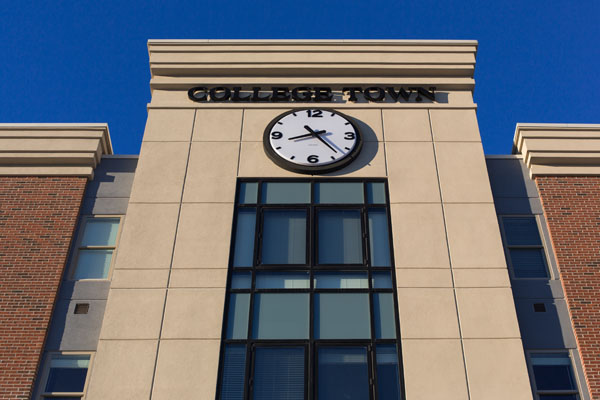 CHANGING TIMES: Once home to the Towne House motor lodge, the College Town location was ripe for reinvention. Neighborhood
groups and the City of Rochester joined the University in planning the development, which offers retail, restaurants, apartments,
a hotel, the University bookstore, and other attractions. (Photo: Adam Fenster)
CHANGING TIMES: Once home to the Towne House motor lodge, the College Town location was ripe for reinvention. Neighborhood
groups and the City of Rochester joined the University in planning the development, which offers retail, restaurants, apartments,
a hotel, the University bookstore, and other attractions. (Photo: Adam Fenster)In building the development, the University is also taking part in a larger movement of urban universities looking to help shape the environments around them and to work in partnership with their neighbors in creating spaces everyone can enjoy.
“There’s a trend to create developments of this sort for purposes of economic development, neighborhood stabilization, and neighborhood enhancement,” Paprocki says. “Vibrant neighborhoods are important for universities, especially those in urban areas.”
The University of Pennsylvania has emerged as a model for such efforts. Shortly after Seligman’s appointment as president, a University group organized by the Office of Government and Community Relations visited Philadelphia to see what Penn had done. The delegation, which included representatives from the City of Rochester and Monroe County, was just one set of visitors among more than 100—representing governors, mayors, think tanks, and universities such as Harvard, Columbia, and the University of Chicago—to make the trip since 2000.
Penn’s actions were spurred by tragedy: the 1994 robbery and murder of a graduate student outside his apartment. Incidents of armed robberies in the neighborhood surrounding the campus soared in the mid ’90s. What happened in 1994 was a “watershed moment” that allowed Penn to catalyze its community to change, says Craig Carnaroli, executive vice president of the university. Penn’s president at the time, Judith Rodin, and the institution’s trustees made transforming the neighborhood a top priority.
“The model of what we did is a very holistic approach and strategy,” Carnaroli says. “We started with the clean-and-safe model, but with elements around housing, public education, infill and amenities, retail and support. And then, finally, the fifth leg: economic inclusion—employment opportunities for local residents. It’s all of those together that has worked over time.”
Because businesses were leery of moving into the area, Penn put its own money behind the effort—against the protests of some who insisted that the funds should be reserved for the university’s core academic mission. “That was a paradigm shift in how the institution saw itself,” says Anthony Sorrentino, executive director of Carnaroli’s office. Today the developments are self-sustaining, crime is down dramatically, and retailers are eager to open stores in the university’s neighborhood.
While the College Town project did not emerge in response to a social context like that which Penn faced, in some respects the process of reinvention was similar. Smoothing the path for Rochester was a vision, largely shared by the University, the city, and neighborhood groups, that emerged in the 1990s. Community members who became actively involved in the revitalization of the area at that time developed a concept called the Strong Neighborhood Plan.
By 2008, representatives from the neighborhood, the University, and the City of Rochester were actively engaged in developing a more comprehensive plan. The city convened a group known as the Mount Hope Task Force, which brought together business people, community members, and city and University leaders to reimagine the area.
Out of that process, the city agreed to rezone the district encompassing what is now College Town, paving the way for several infrastructure improvements. In a plan approved by the Board of Trustees in 2008, the University outlined the goal of developing the area in a way that would provide students, faculty, staff, and visitors with a broader set of amenities and that would establish stronger ties with the surrounding community.
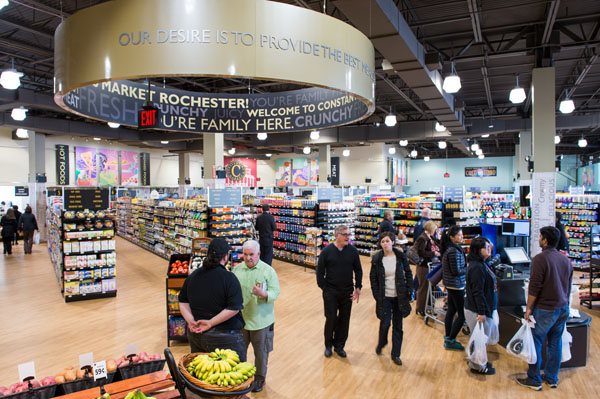 CROSSROADS: College Town has proven attractive to retailers with its location at the busy intersection of Mt. Hope and Elmwood avenues. A new grocery store, Constantino’s (above), opened this spring. Convenient for University employees, a grocery store was a priority for representatives from neighborhood groups. (Photo: Adam Fenster)
CROSSROADS: College Town has proven attractive to retailers with its location at the busy intersection of Mt. Hope and Elmwood avenues. A new grocery store, Constantino’s (above), opened this spring. Convenient for University employees, a grocery store was a priority for representatives from neighborhood groups. (Photo: Adam Fenster)“There was a lot of enthusiasm on the part of the Mt. Hope area. Residents and businesses were really eager to see something like this happen,” Paprocki says. “That’s not always the case. We were very fortunate to have the city facilitate this and have very supportive neighborhood groups, both residents and businesses.”
Added to the city’s interest was support from federal, state, and county agencies and elected officials. Altogether, more than $57 million in publicly financed resources—from grants to tax credits to infrastructure improvements—went into the overall initiative. That broad support was critical, says Josh Farrelman, associate vice president for government and community relations, because each level of government and community engagement helped enhance the support provided from other sources.
For example, the City of Rochester pitched in its own financial support to reconstruct stretches of Mt. Hope and Elmwood avenues, but did so in a way that complemented the broader ideas for College Town. As part of an agreement with Fairmount Properties of Cleveland, Ohio, which had experience in putting together complex financing and public-private partnerships, a federally sponsored loan from the Department of Housing and Urban Development to the City of Rochester and support from a Monroe County economic development agency helped provide the necessary financing. That was important because while the project is located on University-owned land, it does not involve University financing.
And the Finger Lakes Regional Economic Development Council, an initiative launched by New York Gov. Andrew Cuomo, also recognized the project early on, as did federal initiatives to improve public and alternative transportation and to support the establishment of a grocery store in the complex.
“It was a nice marriage of all the stakeholders,” Farrelman says. “Everybody worked together on this for what is a real signature development for Rochester.”
But while the city moved ahead with the improved Mt. Hope Avenue, the economic downturn of 2008 led the University to shelve its plans temporarily. By 2010, “we decided that things were improving enough—let’s give it a try. Let’s see if there’s interest,” Paprocki says. “We had objectives we wanted to fulfill, but we wanted the market to tell us what was feasible.
“There were certain things we desired, like a hotel with conference facilities, retail, restaurants, places where students could go. The neighborhood no longer had a grocery store, and we said that would be very beneficial. So we threw those ideas out, but we let the developers come back with a vision.”
As College Town began to take shape, businesses on the other side of the road—on land not owned by the University, but zoned as part of the College Town area—took notice, and new buildings and businesses have sprouted up there as well.
“What we wanted to do was add vibrancy to our surrounding neighborhoods, and I think College Town will do that,” says Paprocki. In recognition of his efforts in bringing College Town into being, the space in front of the bookstore is named Paprocki Plaza.
The end result is the kind of development that the community had in mind, “and that was because they got us involved,” says Richard Rowe, owner of Rowe Photo, Audio, and Video. He’s the founder of the Mt. Hope Business Association and has played an active role in the development process, including serving on the original Mount Hope Task Force. The group became an important instrument in crafting College Town’s plans, bringing together representatives from the city, neighborhood groups, and the University to hash out issues face to face.
It was a “hard process, but we had all the key stakeholders involved. That is the key, and we were very fortunate that we had a great team,” says current Mt. Hope Business Association president Melanie Warren. “At times it was contentious, but we always could come back and compromise and talk about it.”
She’s been in the neighborhood for 40 years. Now, she says, there’s a new energy, and it’s contagious. “People are thinking about painting, about new facades,” she says.
And with the creation of College Town, the thinking goes, students from the River Campus will have a greater presence on Mt. Hope, as will medical and nursing students and hospital visitors.
“I was really excited for it as an undergrad. As a medical student, I’m even closer than most of the undergrads,” says Leah Dauphin ’13, who completed her second year in the School of Medicine and Dentistry this year. She says she’d like to live in one of the apartments, adding that several members of her class are already moving in.
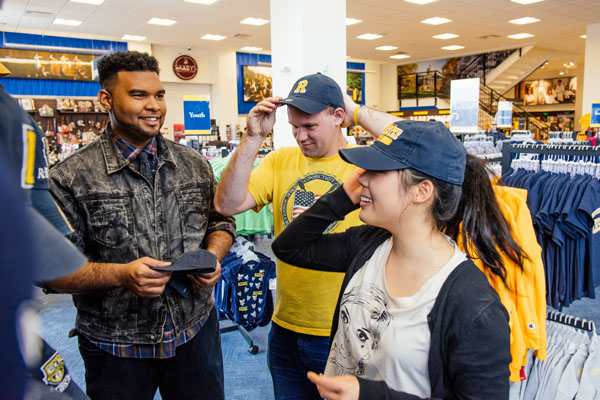 ROCHESTER PRIDE: Students Chris Marsh ’15, Joe Bailey ’15, and Som Liengtiraphan ’17 tour the Barnes & Noble Bookstore at College Town, where the bookstores for the River Campus and the School of Medicine and Dentistry have relocated. A shuttle bus makes frequent loops to College Town, and the bookstore offers a textbook delivery service. (Photo: Brandon Vick)
ROCHESTER PRIDE: Students Chris Marsh ’15, Joe Bailey ’15, and Som Liengtiraphan ’17 tour the Barnes & Noble Bookstore at College Town, where the bookstores for the River Campus and the School of Medicine and Dentistry have relocated. A shuttle bus makes frequent loops to College Town, and the bookstore offers a textbook delivery service. (Photo: Brandon Vick)One notable issue for River Campus students is the relocation of the campus bookstore from the Frederick Douglass Building, beside Wilson Commons, to College Town. “In general students were confused and worried it would be inconvenient, but now that it’s set up and looks so great, they feel like they have something they were missing,” says Antoinette Esce ’15, who was last year’s president of the Students’ Association in the College. The store offers a textbook delivery service to campus, and the new location means that Douglass can change for the better, too.
“People saw this as an opportunity to do something interesting with Douglass. So there’s a major renovation that we’re planning: all the dining areas and some student spaces as well,” says Paprocki. The building will also house the Paul J. Burgett Intercultural Center.
Because College Town is not adjacent to the River Campus, transportation for undergraduates is important, Esce says. A shuttle bus runs regularly between campus and College Town, and a new bike lane will also be created to foster quick travel.
“College Town is still a work in progress. It’s exciting to see each store open up, and to see it all coming to fruition after seeing it on paper for so long,” says Warren. She calls Constantino’s Market, a grocery store that opened in April as part of the development, the “crowning jewel” for neighbors, who had felt the lack of a grocery for more than a decade.
The city’s McCarthy says that College Town “gives an urban alternative to the malls” and is “a destination point to attract people outside the area.” A director of promotion and events has been hired to oversee a farmers market, seasonal celebrations, musical performances, family events, and other happenings.
The development not only serves as a gateway to the University, giving the institution a greater visibility than it has had in the adjoining neighborhood, but also serves as a showcase for the city and the region.
One immediate effect, Paprocki says, will be seen in recruitment and retention of students and faculty. That’s something Penn has noted as well, according to Carnaroli. “It just changed the dynamic where you would automatically show [prospective faculty] the suburbs,” he says. “Now people are more attuned to being around the campus.”
Rowe credits the University with looking beyond the confines of the University and acting on a vision for the larger area. “They understand that whatever happens in the community directly affects their facilities, their employees, their patients, their students, their educators, and the value of their property,” he says. “I’ve been here 45 years—and why I’m so excited and encouraged after 45 years is I see that we’ve only really scratched the potential of what the businesses, the University, and the residents can do together.”

